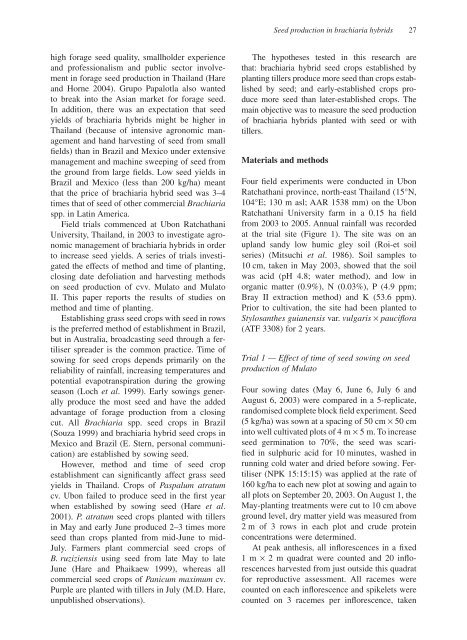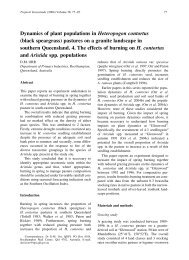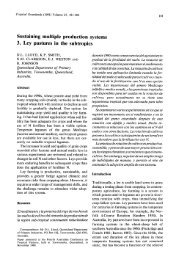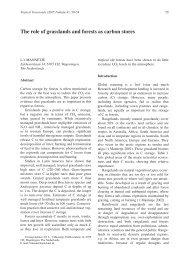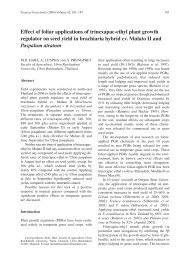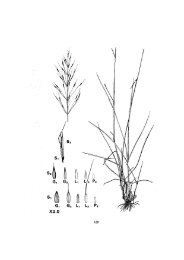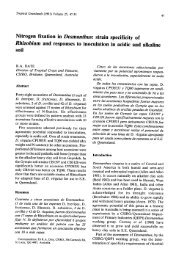Seed production of two brachiaria hybrid cultivars in - Tropical ...
Seed production of two brachiaria hybrid cultivars in - Tropical ...
Seed production of two brachiaria hybrid cultivars in - Tropical ...
Create successful ePaper yourself
Turn your PDF publications into a flip-book with our unique Google optimized e-Paper software.
<strong>Seed</strong> <strong>production</strong> <strong>in</strong> <strong>brachiaria</strong> <strong>hybrid</strong>s 27<br />
high forage seed quality, smallholder experience<br />
and pr<strong>of</strong>essionalism and public sector <strong>in</strong>volvement<br />
<strong>in</strong> forage seed <strong>production</strong> <strong>in</strong> Thailand (Hare<br />
and Horne 2004). Grupo Papalotla also wanted<br />
to break <strong>in</strong>to the Asian market for forage seed.<br />
In addition, there was an expectation that seed<br />
yields <strong>of</strong> <strong>brachiaria</strong> <strong>hybrid</strong>s might be higher <strong>in</strong><br />
Thailand (because <strong>of</strong> <strong>in</strong>tensive agronomic management<br />
and hand harvest<strong>in</strong>g <strong>of</strong> seed from small<br />
fields) than <strong>in</strong> Brazil and Mexico under extensive<br />
management and mach<strong>in</strong>e sweep<strong>in</strong>g <strong>of</strong> seed from<br />
the ground from large fields. Low seed yields <strong>in</strong><br />
Brazil and Mexico (less than 200 kg/ha) meant<br />
that the price <strong>of</strong> <strong>brachiaria</strong> <strong>hybrid</strong> seed was 3–4<br />
times that <strong>of</strong> seed <strong>of</strong> other commercial Brachiaria<br />
spp. <strong>in</strong> Lat<strong>in</strong> America.<br />
Field trials commenced at Ubon Ratchathani<br />
University, Thailand, <strong>in</strong> 2003 to <strong>in</strong>vestigate agronomic<br />
management <strong>of</strong> <strong>brachiaria</strong> <strong>hybrid</strong>s <strong>in</strong> order<br />
to <strong>in</strong>crease seed yields. A series <strong>of</strong> trials <strong>in</strong>vestigated<br />
the effects <strong>of</strong> method and time <strong>of</strong> plant<strong>in</strong>g,<br />
clos<strong>in</strong>g date defoliation and harvest<strong>in</strong>g methods<br />
on seed <strong>production</strong> <strong>of</strong> cvv. Mulato and Mulato<br />
II. This paper reports the results <strong>of</strong> studies on<br />
method and time <strong>of</strong> plant<strong>in</strong>g.<br />
Establish<strong>in</strong>g grass seed crops with seed <strong>in</strong> rows<br />
is the preferred method <strong>of</strong> establishment <strong>in</strong> Brazil,<br />
but <strong>in</strong> Australia, broadcast<strong>in</strong>g seed through a fertiliser<br />
spreader is the common practice. Time <strong>of</strong><br />
sow<strong>in</strong>g for seed crops depends primarily on the<br />
reliability <strong>of</strong> ra<strong>in</strong>fall, <strong>in</strong>creas<strong>in</strong>g temperatures and<br />
potential evapotranspiration dur<strong>in</strong>g the grow<strong>in</strong>g<br />
season (Loch et al. 1999). Early sow<strong>in</strong>gs generally<br />
produce the most seed and have the added<br />
advantage <strong>of</strong> forage <strong>production</strong> from a clos<strong>in</strong>g<br />
cut. All Brachiaria spp. seed crops <strong>in</strong> Brazil<br />
(Souza 1999) and <strong>brachiaria</strong> <strong>hybrid</strong> seed crops <strong>in</strong><br />
Mexico and Brazil (E. Stern, personal communication)<br />
are established by sow<strong>in</strong>g seed.<br />
However, method and time <strong>of</strong> seed crop<br />
establishment can significantly affect grass seed<br />
yields <strong>in</strong> Thailand. Crops <strong>of</strong> Paspalum atratum<br />
cv. Ubon failed to produce seed <strong>in</strong> the first year<br />
when established by sow<strong>in</strong>g seed (Hare et al.<br />
2001). P. atratum seed crops planted with tillers<br />
<strong>in</strong> May and early June produced 2–3 times more<br />
seed than crops planted from mid-June to mid-<br />
July. Farmers plant commercial seed crops <strong>of</strong><br />
B. ruziziensis us<strong>in</strong>g seed from late May to late<br />
June (Hare and Phaikaew 1999), whereas all<br />
commercial seed crops <strong>of</strong> Panicum maximum cv.<br />
Purple are planted with tillers <strong>in</strong> July (M.D. Hare,<br />
unpublished observations).<br />
The hypotheses tested <strong>in</strong> this research are<br />
that: <strong>brachiaria</strong> <strong>hybrid</strong> seed crops established by<br />
plant<strong>in</strong>g tillers produce more seed than crops established<br />
by seed; and early-established crops produce<br />
more seed than later-established crops. The<br />
ma<strong>in</strong> objective was to measure the seed <strong>production</strong><br />
<strong>of</strong> <strong>brachiaria</strong> <strong>hybrid</strong>s planted with seed or with<br />
tillers.<br />
Materials and methods<br />
Four field experiments were conducted <strong>in</strong> Ubon<br />
Ratchathani prov<strong>in</strong>ce, north-east Thailand (15°N,<br />
104°E; 130 m asl; AAR 1538 mm) on the Ubon<br />
Ratchathani University farm <strong>in</strong> a 0.15 ha field<br />
from 2003 to 2005. Annual ra<strong>in</strong>fall was recorded<br />
at the trial site (Figure 1). The site was on an<br />
upland sandy low humic gley soil (Roi-et soil<br />
series) (Mitsuchi et al. 1986). Soil samples to<br />
10 cm, taken <strong>in</strong> May 2003, showed that the soil<br />
was acid (pH 4.8; water method), and low <strong>in</strong><br />
organic matter (0.9%), N (0.03%), P (4.9 ppm;<br />
Bray II extraction method) and K (53.6 ppm).<br />
Prior to cultivation, the site had been planted to<br />
Stylosanthes guianensis var. vulgaris × paucifl ora<br />
(ATF 3308) for 2 years.<br />
Trial 1 — Effect <strong>of</strong> time <strong>of</strong> seed sow<strong>in</strong>g on seed<br />
<strong>production</strong> <strong>of</strong> Mulato<br />
Four sow<strong>in</strong>g dates (May 6, June 6, July 6 and<br />
August 6, 2003) were compared <strong>in</strong> a 5-replicate,<br />
randomised complete block field experiment. <strong>Seed</strong><br />
(5 kg/ha) was sown at a spac<strong>in</strong>g <strong>of</strong> 50 cm × 50 cm<br />
<strong>in</strong>to well cultivated plots <strong>of</strong> 4 m × 5 m. To <strong>in</strong>crease<br />
seed germ<strong>in</strong>ation to 70%, the seed was scarified<br />
<strong>in</strong> sulphuric acid for 10 m<strong>in</strong>utes, washed <strong>in</strong><br />
runn<strong>in</strong>g cold water and dried before sow<strong>in</strong>g. Fertiliser<br />
(NPK 15:15:15) was applied at the rate <strong>of</strong><br />
160 kg/ha to each new plot at sow<strong>in</strong>g and aga<strong>in</strong> to<br />
all plots on September 20, 2003. On August 1, the<br />
May-plant<strong>in</strong>g treatments were cut to 10 cm above<br />
ground level, dry matter yield was measured from<br />
2 m <strong>of</strong> 3 rows <strong>in</strong> each plot and crude prote<strong>in</strong><br />
concentrations were determ<strong>in</strong>ed.<br />
At peak anthesis, all <strong>in</strong>florescences <strong>in</strong> a fixed<br />
1 m × 2 m quadrat were counted and 20 <strong>in</strong>florescences<br />
harvested from just outside this quadrat<br />
for reproductive assessment. All racemes were<br />
counted on each <strong>in</strong>florescence and spikelets were<br />
counted on 3 racemes per <strong>in</strong>florescence, taken


